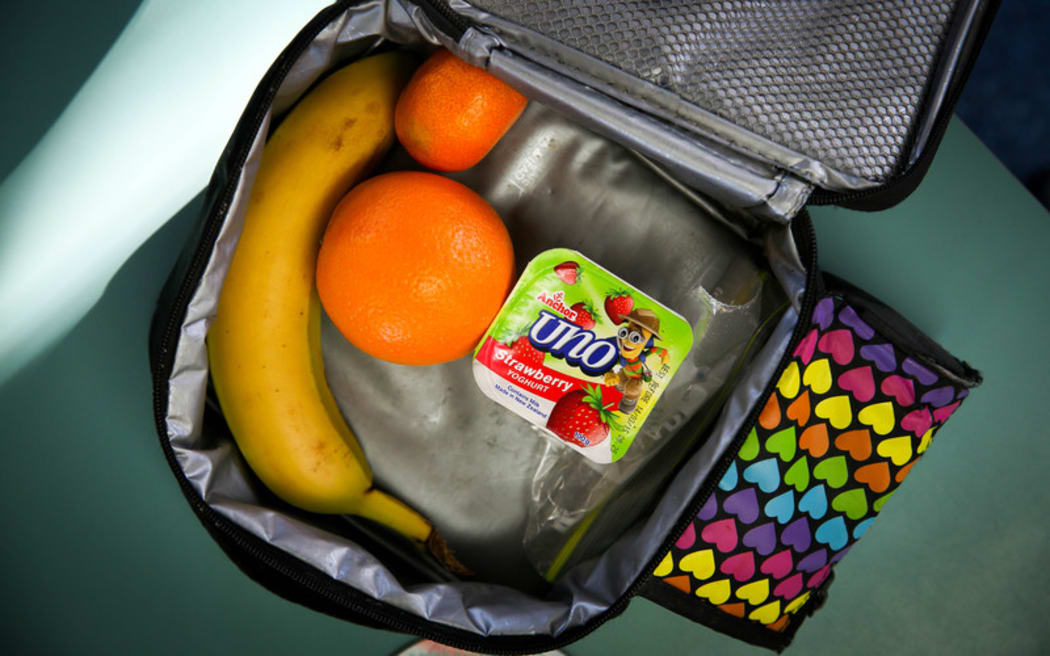In a world-first, Kiwi school students will help scientists find out how fructose affects the development of obesity, particularly for Māori and Pacific Islanders.

Lunch box. Photo: RNZ / Alexander Robertson
The research, involving about 2000 students in its first year, would be carried out in partnerships with schools, with teachers and students undertaking some of the experiments themselves.
Auckland University Maurice Wilkins Centre Professor Peter Shepherd said the study would look at why some people were more likely to absorb fructose than others.
He said much less was known about fructose, which was found in fruit, than glucose which was found in starches.
"Sucrose - our white table sugar or even our brown table sugar, really all the things we call sugar - are actually half glucose and half fructose."
He said it was the body's absorption of fructose that could lead to obesity.
"We all absorb glucose very well, but we all have huge differences in the way we absorb and metabolise the fructose part of it.
"Fructose is way worse for you - our body is hard-wired to use glucose and it's the main energy source in our body and it's always in our circulation."
But too much fructose could lead to fat deposits and uric acid, which caused gout, he said.
Parents shouldn't worry too much about kids eating too much fruit, however, with Prof Shepherd saying although it might not be best to have five servings all at once, eating in moderation each day was fine.
New Zealand the perfect place for this study
Prof Shepherd said the idea for the study in New Zealand had come about from good communication between the centre and school teachers.
"They're a really highly motivated cohort and we're really lucky in New Zealand to have such great high school biology teachers out there.
"They've been really asking us - so we've got lot's of volunteer schools but we'll focus initially mainly on schools in Auckland," he said.
And New Zealand and its can-do attitude had been perfect for that.
"Because we're small and we sort of all know each other, and we can sort of link up with all the school teachers, it's a lot easier for us to do all this.
"It's actually snowballed and we've got way more support than I thought we would get for this.
Ōtāhuhu College, Waitakere College, Epsom Girls Grammar School, Dillworth, Opotiki College and two colleges in Nelson would be taking part in the pilot, which would involve a simple breath test for hydrogen, which would measure fructose absorption.
"There's two things that can happen to [the fructose], it can get absorbed in the gut and the bloodstream, or it can keep going through your bowels and come out the other end.
"And if it does the latter, then it will meet all the bacteria that are in your colon and it will start making gas and that gas will get into your blood and some of that gas will come out through your lungs - and we can test for that with a breath test."
Teachers would begin taking students through the pilot programmes next year, and an app which fed medical information into databases would help make initial results available fairly quickly.
Why Māori and Pacific?
He said the Māori and Pasifika communities were suffering the most from metabolic problems, and the first tests would be at Ōtāhuhu College, which had a strong Māori and Pacific Island contingent.
He said one theory was that people living in warmer parts of the world had evolved to be better at absorbing the fructose from fruit because it was more likely to grow well in warmer places.
He said the trend of fructose absorption did tend to affect people from similarly warm places like the Middle East and Africa as well, but in a different way.
"The rates of obesity in places like the Arab countries where they use a lot of dates as a food source, which have a very high content of sugar for example, and the type of issues with obesity you get in countries like India tend to be more about the fat depositing in the liver rather than what we would think of as obesity with it under the skin."
But all those countries tended to have problems with excess deposition of fat in one form or another.
"I think glucose is the most available sugar in our diet, it comes from starches and we've evolved to become really dependent on it as a sugar. The other one, it comes from fruits and sources like that and it was available seasonally.
"I guess it's better to have some energy on board than none at all in historical times, so it's a back-up energy source but it's certainly not the preferred one for our body."
He said as well as looking at preventing obesity, the team wanted to use the information to link it to educational messages and learning at schools, and also encourage those students to get into science.
"They're also schools that tend to have lower participation in science and people coming through to Year 11, 12, 13 with science subjects.
"What we're hoping this will do is enthuse and excite students about science and encourage them to keep going in those science subjects."

